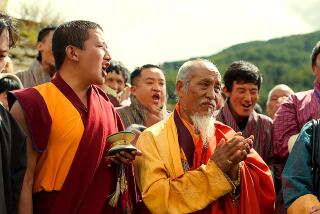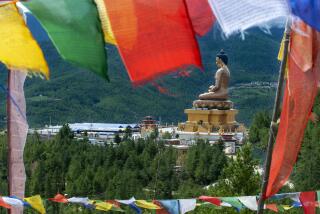Bhutan Looks Toward Future While Staying Rooted in the Past
- Share via
THIMPHU, Bhutan — Once every two years, King Jigme Singye Wangchuck climbs into his Land Cruiser and heads out to meet his people. Often, his four wives and some of his 10 children go along, but there’s hardly any security.
In dozens of local meetings during the biannual ritual, the 42-year-old king of Bhutan and his ministers discuss the latest development plans and decide where to build a bridge, a clinic, a school.
Such people-to-government contact is possible in a small nation like Bhutan, with only 600,000 people. While political chaos afflicts its democratic neighbors--India, Pakistan, Nepal, Bangladesh--Bhutan’s monarchy is a refuge of stability.
It’s a way of life the king will go to sometimes desperate lengths to protect.
In a January report, Amnesty International, the London-based human rights group, accused Bhutan of arresting and torturing dozens of pro-democracy activists, including Buddhist monks and teachers. A few years ago, Bhutan cracked down to stop what it considered a flood of immigrants, raising earlier concerns about human rights in the kingdom.
But the king remains widely admired. Even his harshest critics at the height of the immigration controversy did not call for an end to the monarchy, seeking only to limit its powers.
To the few visitors allowed in each year, this Buddhist kingdom high in the Himalayas is a magical land of legendary dragons, demons and deities. Its forests are vast and bountiful--and actually spreading. Its rivers are swift and clean. The crisp air is scented with pine.
The Bhutanese call their home Druk Yul--Land of the Thunder Dragon, a name derived from traditional stories that its branch of Mahayana, or Tibetan, Buddhism was conceived amid much thunder and lightning.
In the towns and villages huddled in the valleys, Buddhist good luck symbols adorn window frames and roof beams and often the white stone walls. Citizens are required to wear traditional dress: men a kilt that falls to the knee called the kho, women a robe known as the kira.
In the debate on development vs. environment and globalization vs. tradition, Bhutan has chosen the conservative path, with some twists--among them the government’s home page on the Internet to provide information to outsiders.
Thimphu, the capital (population 40,000), has no neon signs, no traffic lights, no pizzerias or fast-food chains. It has only one newspaper--a weekly.
A Japanese-installed microwave system has spread telephone service to most parts of the country, but private phones are rare, especially in rural areas.
State-run radio broadcasts traditional music, news and talk shows, but there is no television service, and satellite dishes that could receive foreign broadcasts are banned.
But the government sends 1,000 of its best students to leading Western universities each year. And Bhutanese children are taught in English rather than the local language, Dzongkha.
Bhutan’s leaders say that while defending their culture is a priority, English is a necessary tool in today’s world. “When we leave Bhutan, we leave our language at the airport,” Trade Minister Om Pradhan said.
And while there are no television broadcasts, many urban Bhutanese own VCRs and TV monitors so they can rent videos of foreign movies.
“In some ways, it’s nice not to have television. Once you’re exposed to things from the outside, you might get carried away,” said the proprietor of a video rental shop.
“But I think it would be better to have TV, to see what’s happening around the world. We are too limited,” he added, asking to remain anonymous, as did others critical of the system.
Bhutan’s cautious approach to the outside world is dictated by its location, squeezed between the two most populous countries on earth, China and India.
It has watched other traditional Buddhist societies disappear as independent nations. Tiny Ladakh was swallowed when India was still under British colonial rule. Tibet fell under the control of China. Sikkim was overwhelmed by Indian and Nepalese migrants and then absorbed by India.
“The biggest challenge for us is political and cultural survival,” said Bhutan’s foreign minister, Dawa Tsering.
Still, the future is being quietly discussed, both by ordinary people like the video shop owner and by the king’s inner circle of technocrats.
State radio recently broadcast a debate among high school students who split evenly, with half saying they wanted the freedom to wear jeans and watch television, the other half supporting traditional ways.
“We will have no choice but to be more outward looking. The economy is not like it once was,” Finance Secretary Yeshey Zimba said in an interview.
Until a few decades ago, Bhutan lived an isolated and medieval agrarian life. In 1961 it had no paved roads, no electricity, no hospitals, no communications and only 11 schools, with 440 students. Goods were bartered rather than bought.
Then the Bhutanese started gradually expanding outside contacts with exports of lumber and other timber products.
Ten years ago, Bhutan began tapping the powerful rivers tumbling down the Himalayas to generate electricity, and now one-third of its income comes from selling power to India--which accounts for 85% of Bhutan’s foreign trade.
Work began last year on a 400-megawatt power station near the Indian border that could be a big boost to earnings. “We want to have the revenue of a small Arab oil-exporting country,” the foreign minister said.
With a growth rate averaging 6.7% a year, Bhutan’s gross domestic product grew from $190 million in 1985 to $330 million last year. Annual per-capita income is up from $400 five years ago to $545.
Other indicators of national health have climbed sharply too. Over the last decade, life expectancy jumped from 45 to 66 years, the literacy rate rose from 23% to 54%, infant mortality was halved to 70 per 1,000 births.
Much remains to be done, the country’s leaders say. Nearly 85% of Bhutan’s people live in farming villages, often many days’ walk from the nearest road. In a country slightly larger than Switzerland and equally mountainous, the capital is three days by bus from the eastern provinces. There are no local airstrips.
But some Bhutanese are uneasy. Shantytowns have appeared on the outskirts of Thimphu. Rush-hour traffic occasionally jams up on the capital’s one commercial street. More bars are appearing in the city, and garbage and pollution are noticeable.
Seeing the environmental degradation of its neighbors, Bhutan has little interest in foreign investment, has no aspirations to become an industrial power and even discourages tourism to preserve its pristine mountains and forests.
At the core of the country’s insulation is the fear of Drupkas--the Buddhist ethnic group of the north to which the king belongs--that they will lose their status as the majority if too much development lures foreign workers.
In a bid to control the number of ethnic Nepalese Hindus moving into labor-short Bhutan, the government decreed in 1988 that anyone who did not have relatives in Bhutan before 1958 had to leave.
A pro-democracy movement erupted in the Nepalese-dominated south, prompting a government crackdown and the expulsion of thousands, leaving 90,000 people claiming Bhutanese citizenship still living in U.N.-run refugee camps in Nepal today.
Democracy campaigners are also active in eastern Bhutan, where the people are mostly Buddhist but followers of a different religious branch than the majority Drupkas. Amnesty International said activists in the east were subjected to arbitrary arrest, prolonged detention without charge or trial, and torture in 1997.
More to Read
Sign up for Essential California
The most important California stories and recommendations in your inbox every morning.
You may occasionally receive promotional content from the Los Angeles Times.










